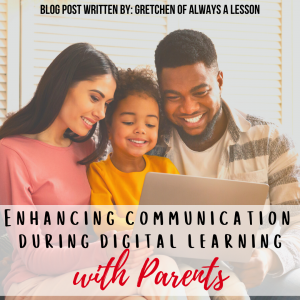Enhancing Communication during Digital Learning with Parents
Communication during digital learning can be an obstacle, but not an insurmountable one.
This series of posts will outline ways to communicate with various stakeholders (administrators, colleagues, and students) during digital learning as well as share what type of information to communicate.
Although digital learning looks different for everyone right now during Covid-19 shutdowns, the truth is no one is exempt from digital learning in some form or fashion. Distance learning is here to stay for the foreseeable future which means we better figure out how to make it successful.
Enhancing communication is essential to continue on a path of learning and growth for stakeholders like administration, colleagues, students and parents.
 Enhance Communication with Parents
Enhance Communication with Parents
- Provide learning snapshots – Parents love to see learning in action. Many parents are at home right now during virtual learning so they might catch a glimpse inside of your online classroom. But it’s fun for parents to see some snapshots of learning in action (ie. student presentations or shining star moments).
- Share a calendar of events– Knowledge is power. Share with parents a calendar of special events (ie. themed learning days), due dates (assessments or projects), or topics being covered in class. Staying up-to-date on what’s happening in their child’s classroom will increase parental support for the work you are doing daily.
- Be available for questions or concerns– Parents want access to you for a myriad of reasons. Beyond email support, extend specific office hours where they can meet face-to-face virtually to chat. Many times parents want to share additional information with you or feel heard about a specific topic, so provide time and space to do that.
- Give specifics about student performance– Continue to set up Parent-Teacher Conferences just as if you were teaching in-person. Parents rely on those meetings to receive details on their child’s development as it relates to meeting state and district requirements and expectations. Providing specific data points, both informal and formal, will help parents know exactly where their child is performing against the expectations. Don’t hold back on how students are learning, including obstacles and successes.
- Give tips for how to continue learning at home– Some students will need extension opportunities while others need time to review and practice previously learned skills. Share with parents tips for how to continue learning at home. Keep it simple, light and fun!
Consistent, on-going communicating with stakeholders during remote learning is of utmost importance to make the school year successful for all. Using communication tools like Google Meet, Skype, Zoom and FaceTime are great for connecting face-to-face in a virtual world. Using Voxer, email, and text are helpful to staying connected on a daily basis through voice or print.
Whatever tool or strategy you employ, enhancing communication during remote learning is the goal to success for everyone involved.
Need resources for communicating with parents? Click here.
How are you communicating with parents during remote learning?

